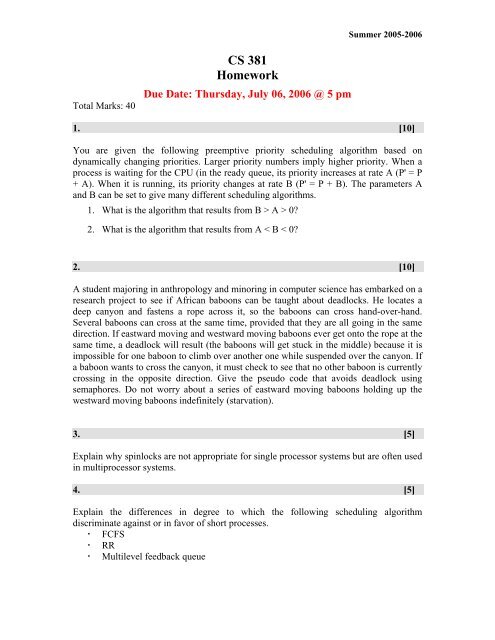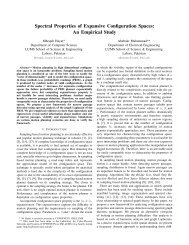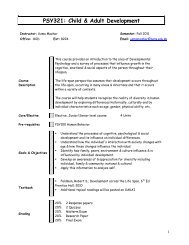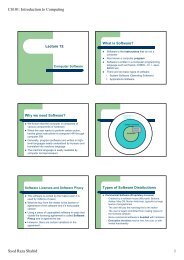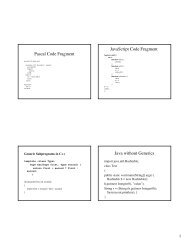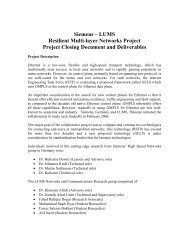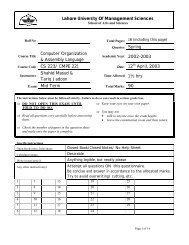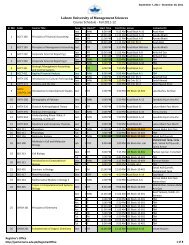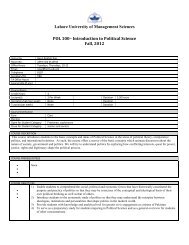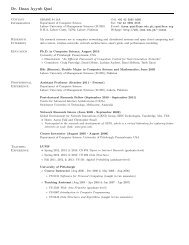CS381 Homework - Suraj @ LUMS
CS381 Homework - Suraj @ LUMS
CS381 Homework - Suraj @ LUMS
You also want an ePaper? Increase the reach of your titles
YUMPU automatically turns print PDFs into web optimized ePapers that Google loves.
Summer 2005-2006<br />
Total Marks: 40<br />
CS 381<br />
<strong>Homework</strong><br />
Due Date: Thursday, July 06, 2006 @ 5 pm<br />
1. [10]<br />
You are given the following preemptive priority scheduling algorithm based on<br />
dynamically changing priorities. Larger priority numbers imply higher priority. When a<br />
process is waiting for the CPU (in the ready queue, its priority increases at rate A (P' = P<br />
+ A). When it is running, its priority changes at rate B (P' = P + B). The parameters A<br />
and B can be set to give many different scheduling algorithms.<br />
1. What is the algorithm that results from B > A > 0<br />
2. What is the algorithm that results from A < B < 0<br />
2. [10]<br />
A student majoring in anthropology and minoring in computer science has embarked on a<br />
research project to see if African baboons can be taught about deadlocks. He locates a<br />
deep canyon and fastens a rope across it, so the baboons can cross hand-over-hand.<br />
Several baboons can cross at the same time, provided that they are all going in the same<br />
direction. If eastward moving and westward moving baboons ever get onto the rope at the<br />
same time, a deadlock will result (the baboons will get stuck in the middle) because it is<br />
impossible for one baboon to climb over another one while suspended over the canyon. If<br />
a baboon wants to cross the canyon, it must check to see that no other baboon is currently<br />
crossing in the opposite direction. Give the pseudo code that avoids deadlock using<br />
semaphores. Do not worry about a series of eastward moving baboons holding up the<br />
westward moving baboons indefinitely (starvation).<br />
3. [5]<br />
Explain why spinlocks are not appropriate for single processor systems but are often used<br />
in multiprocessor systems.<br />
4. [5]<br />
Explain the differences in degree to which the following scheduling algorithm<br />
discriminate against or in favor of short processes.<br />
• FCFS<br />
• RR<br />
• Multilevel feedback queue
Summer 2005-2006<br />
5. [10]<br />
Consider a system consisting of m resources of the same type being shared by n<br />
processes. Resources can only be requested and released by processes one at a time (i.e.<br />
they are non-sharable type). Show that the system is deadlock free if the following two<br />
conditions hold:<br />
• The maximum need of each process is between 1 and m resources<br />
• The sum of all maximum needs is less than m+n<br />
Hint: Show that the there exists a process P i whose Need i is zero. (I.e. it has at least one<br />
resource it can release and hence the system cannot be in a deadlock state.)<br />
Submission Instructions:<br />
o Instructions about how and where to submit your homework will be posted on the<br />
course website.


